Multi-Objective Scheduling of Fuel Treatments to Implement a Linear Fuel Break Network
Abstract
1. Introduction
2. Materials and Methods
2.1. Study Area
2.2. Fuel Break Network
2.3. Forest Vegetation
2.4. Fuel Break Treatments
2.5. Financial Valuation
2.6. Wildfire Hazard
2.7. Treatment Unit Aggregation for Project Areas
2.8. Scenarios
3. Results
3.1. Effect of Treatment Area Per Project on Objective Values
3.2. Tradeoffs between Fire Hazard and Revenue
3.3. Optimizing Potential Revenue Treatments
3.4. Multi-Objective Scenario
4. Discussion
Supplementary Materials
Author Contributions
Funding
Acknowledgments
Conflicts of Interest
References
- Ascoli, D.; Russo, L.; Giannino, F.; Siettos, C.; Moreira, F. Firebreak and Fuelbreak. In Encyclopedia of Wildfires and Wildland-Urban Interface (WUI) Fires; Manzello, S.L., Ed.; Springer International Publishing: Cham, Switzerland, 2018; pp. 1–9. [Google Scholar]
- Maestas, J.; Pellant, M.; Okeson, L.; Tilley, D.; Havlina, D.; Cracroft, T.; Brazee, B.; Williams, M.; Messmer, D. Fuel Breaks to Reduce Large Wildfire Impacts in Sagebrush Ecosystems; USA-NRCS: Boise, ID, USA, 2016. [Google Scholar]
- Shinneman, D.J.; Germino, M.J.; Pilliod, D.S.; Aldridge, C.L.; Vaillant, N.M.; Coates, P.S. The ecological uncertainty of wildfire fuel breaks: Examples from the sagebrush steppe. Front. Ecol. Environ. 2019, 17, 279–288. [Google Scholar] [CrossRef]
- Syphard, A.D.; Keeley, J.E.; Brennan, T.J. Factors affecting fuel break effectiveness in the control of large fires on the Los Padres National Forest, California. Int. J. Wildland Fire 2011, 20, 764–775. [Google Scholar] [CrossRef]
- Xanthopoulos, G.; Caballero, D.; Galante, M.; Alexandrian, D.; Rigolot, E.; Marzano, R. Forest fuels management in Europe. In Fuels Management. How to Measure Success; Andrews, P.L., Butler, B.W., Eds.; Portland, OR, USA, 2006. Available online: https://www.fs.usda.gov/rm/pubs/rmrs_p041.pdf (accessed on 10 October 2022).
- Oliveira, T.M.; Barros, A.M.G.; Ager, A.A.; Fernandes, P.M. Assessing the effect of a fuel break network to reduce burnt area and wildfire risk transmission. Int. J. Wildland Fire 2016, 25, 619–632. [Google Scholar] [CrossRef]
- Zong, X.; Tian, X.; Wang, X. An optimal firebreak design for the boreal forest of China. Sci. Total Environ. 2021, 781, 146822. [Google Scholar] [CrossRef]
- Green, L.R. Fuelbreaks and Other Fuel Modification for Wildland Fire Control; US Department of Agriculture, Forest Service: Washington, DC, USA, 1977. Available online: https://www.fs.usda.gov/research/treesearch/33461 (accessed on 10 October 2022).
- Eastaugh, C.S.; Molina, D.M. Forest road and fuelbreak siting with respect to reference fire intensities. For. Syst. 2012, 21, 153–161. [Google Scholar] [CrossRef]
- O’Connor, C.D.; Calkin, D.E.; Thompson, M.P. An empirical machine learning method for predicting potential fire control locations for pre-fire planning and operational fire management. Int. J. Wildland Fire 2017, 26, 587–597. [Google Scholar] [CrossRef]
- Caggiano, M.D. Collaboratively Engaging Stakeholders to Develop Operational Delineations; CFRI-1908; Colorado State University: Fort Collins, CO, USA, 2019; Available online: https://cfri.colostate.edu/wp-content/uploads/sites/22/2019/08/PODs-Collaborative-Engagement-Final-Report.pdf (accessed on 10 October 2022).
- Varela, E.; Giergiczny, M.; Riera, P.; Mahieu, P.A.; Solino, M. Social preferences for fuel break management programs in Spain: A choice modelling application to prevention of forest fires. Int. J. Wildland Fire 2014, 23, 281–289. [Google Scholar] [CrossRef]
- Price, O.F.; Edwards, A.C.; Russell-Smith, J. Efficacy of permanent firebreaks and aerial prescribed burning in western Arnhem Land, Northern Territory, Australia. Int. J. Wildland Fire 2007, 16, 295–305. [Google Scholar] [CrossRef]
- O’Connor, C.; Thompson, M.; Rodríguez y Silva, F. Getting ahead of the wildfire problem: Quantifying and mapping management challenges and opportunities. Geosciences 2016, 6, 35. [Google Scholar] [CrossRef]
- Aubard, V.; Pereira-Pires, J.E.; Campagnolo, M.L.; Pereira, J.; Mora, A.; Silva, J. Fully automated countrywide monitoring of fuel break maintenance operations. Remote Sens. 2020, 12, 2879. [Google Scholar] [CrossRef]
- Rodríguez-Puerta, F.; Ponce, R.A.; Pérez-Rodríguez, F.; Águeda, B.; Martín-García, S.; Martínez-Rodrigo, R.; Lizarralde, I. Comparison of Machine Learning Algorithms for Wildland-Urban Interface Fuelbreak Planning Integrating ALS and UAV-borne LiDAR Data and Multispectral Images. Drones 2020, 4, 21. [Google Scholar] [CrossRef]
- Finney, M.A. An overview of FlamMap fire modeling capabilities. In Fuels Management-How to Measure Success, Proceedings RMRS-P-41, Fort Collins, CO, USA, 28–30 March 2006; Andrews, P.L., Butler, B.W., Eds.; USDA Forest Service, Rocky Mountain Research Station: Fort Collins, CO, USA, 2006; pp. 213–220. Available online: https://www.fs.usda.gov/research/treesearch/25948. (accessed on 10 October 2022).
- Finney, M.A.; McHugh, C.W.; Grenfell, I.C.; Riley, K.L.; Short, K.C. A simulation of probabilistic wildfire risk components for the continental United States. Stoch. Environ. Res. Risk Assess. 2011, 25, 973–1000. [Google Scholar] [CrossRef]
- Ager, A.A.; Lasko, R.; Myroniuk, V.; Zibtsev, S.; Day, M.A.; Usenia, U.; Bogomolov, V.; Kovalets, I.; Evers, C.R. The wildfire problem in areas contaminated by the Chernobyl disaster. Sci. Total Environ. 2019, 696, 133954. [Google Scholar] [CrossRef]
- Aparício, B.A.; Alcasena, F.; Ager, A.A.; Chung, W.; Pereira, J.M.C. Evaluating priority locations and potential benefits for building a nation-wide fuel break network in Portugal. J. Environ. Manag. 2022, 320, 115920. [Google Scholar] [CrossRef] [PubMed]
- Parisien, M.A.; Parks, S.A.; Miller, C.; Krawchuk, M.A.; Heathcott, M.; Moritz, M.A. Contributions of ignitions, fuels, and weather to the spatial patterns of burn probability of a boreal landscape. Ecosystems 2011, 14, 1141–1155. [Google Scholar] [CrossRef]
- Pais, C.; Carrasco, J.; Martell, D.L.; Weintraub, A.; Woodruff, D.L. Cell2Fire: A Cell Based Forest Fire Growth Model. 2019, p. 47. Available online: https://www.frontiersin.org/articles/10.3389/ffgc.2021.692706/full (accessed on 10 October 2022).
- Chung, W.; Jones, G.; Krueger, K.; Bramel, J.; Contreras, M. Optimising fuel treatments over time and space. Int. J. Wildland Fire 2013, 22, 1118–1133. [Google Scholar] [CrossRef]
- Ager, A.A.; Vaillant, N.M.; Finney, M.A. Integrating fire behavior models and geospatial analysis for wildland fire risk assessment and fuel management planning. J. Combust. 2011, 2011, 572452. [Google Scholar] [CrossRef]
- Massada, A.B.; Radeloff, V.C.; Stewart, S.I. Allocating fuel breaks for optimal protection of structures in the wildland-urban interface. Int. J. Wildland Fire 2011, 20, 59–68. [Google Scholar] [CrossRef]
- Benali, A.; Sá, A.C.L.; Pinho, J.; Fernandes, P.M.; Pereira, J.M.C. Understanding the impact of different landscape-level fuel management strategies on wildfire hazard in Central Portugal. Forests 2021, 12, 522. [Google Scholar] [CrossRef]
- Pais, C.; Carrasco, J.; Elimbi Moudio, P.; Shen, Z.-J.M. Downstream protection value: Detecting critical zones for effective fuel-treatment under wildfire risk. Comput. Oper. Res. 2021, 131, 105252. [Google Scholar] [CrossRef]
- Russo, L.; Russo, P.; Siettos, C.I. A complex network theory approach for the spatial distribution of fire breaks in heterogeneous forest landscapes for the control of wildland fires. PLoS ONE 2016, 11, e0163226. [Google Scholar] [CrossRef] [PubMed]
- Wei, Y. Optimize landscape fuel treatment locations to create control opportunities for future fires. Can. J. For. Res. 2012, 42, 1002–1014. [Google Scholar] [CrossRef]
- Rashidi, E.; Medal, H.; Hoskins, A. An attacker-defender model for analyzing the vulnerability of initial attack in wildfire suppression. Nav. Res. Logist. 2018, 65, 120–134. [Google Scholar] [CrossRef]
- Penman, T.; Collins, L.; Price, O.; Bradstock, R.; Metcalf, S.; Chong, D. Examining the relative effects of fire weather, suppression and fuel treatment on fire behaviour–A simulation study. J. Environ. Manag. 2013, 131, 325–333. [Google Scholar] [CrossRef]
- Syphard, A.D.; Keeley, J.E.; Brennan, T.J. Comparing the role of fuel breaks across southern California national forests. For. Ecol. Manag. 2011, 261, 2038–2048. [Google Scholar] [CrossRef]
- AGIF. National Plan for Integrated Wildfire Management 2020–2030; Agency for Integrated Rural Fire Management: Lisbon, Portugal, 2020; p. 166. [Google Scholar]
- Baskent, E.Z.; Keles, S. Spatial forest planning: A review. Ecol. Model. 2005, 188, 145–173. [Google Scholar] [CrossRef]
- Crooks, K.R.; Sanjayan, M.A. Connectivity Conservation; Cambridge University Press: Cambridge, UK, 2006; p. 736. [Google Scholar]
- USDA Forest Service. Bailey’s Ecoregions of the Conterminous United States. United States Geological Survey. Available online: https://www.sciencebase.gov/catalog/item/54244abde4b037b608f9e23d (accessed on 10 October 2022).
- Short, K.C. Spatial Wildfire Occurrence Data for the United States, 1992-2020 [FPA_FOD_20221014], 6th ed.; Forest Service Research Data Archive: Fort Collins, CO, USA, 2022. [Google Scholar] [CrossRef]
- Infrastructure Investment and Jobs Act, Public Law 117-58. 2021. Available online: https://www.congress.gov/117/plaws/publ58/PLAW-117publ58.pdf (accessed on 10 October 2022).
- Dennis, F.C. Fuelbreak Guidelines for Forested Subdivisions & Communities; Colorado State Forest Service, 2005; p. 8. Available online: https://mountainscholar.org/handle/10217/45082 (accessed on 10 October 2022).
- Mooney, C. Fuelbreak Effectiveness in Canada’s Boreal Forests: A Synthesis of Current Knowledge. 2010, p. 53. Available online: https://library.fpinnovations.ca/media/FOP/9438.pdf (accessed on 10 October 2022).
- Ingalsbee, T. Fuelbreaks for wildland fire management: A moat or a drawbridge for ecosystem fire restoration. Fire Ecol. 2005, 1, 85–99. [Google Scholar] [CrossRef]
- USDA Forest Service, Pacific Northwest Region. Land and Resource Management Plan. Umatilla National Forest; USDA Forest Service, Pacific Northwest Region: Portland, OR, USA, 1990. [Google Scholar]
- Belavenutti, P.; Chung, W.; Ager, A.A. The economic reality of the forest and fuel management deficit on a fire prone western US national forest. J. Environ. Manag. 2021, 293, 112825. [Google Scholar] [CrossRef]
- Keyser, C.E.; Dixon, G.E. Blue Mountains (BM) Variant Overview—Forest Vegetation Simulator; USDA Forest Service, Forest Management Service Center: Fort Collins, CO, USA, 2015; p. 56. [Google Scholar]
- Keyes, C.R.; O’Hara, K.L. Quantifying stand targets for silvicultural prevention of crown fires. West. J. Appl. For. 2002, 17, 101–109. [Google Scholar] [CrossRef]
- USDA and USDI. Record of Decision for Amendments to Forest Service and Bureau of Land Management Planning Departments within the Range of the Northern Spotted Owl; USDA Forest Service and USDI Bureau of Land Management: Portland, OR, USA, 1994. [Google Scholar]
- USDA Forest Service, Pacific Northwest Region, Management Direction for Large Diameter Trees in Eastern OR & Southeastern WA; USDA Forest Service, Pacific Northwest Region, 2021. Available online: https://www.fs.usda.gov/detail/r6/landmanagement/planning/?cid=FSEPRD710229 (accessed on 10 October 2022).
- Jain, T.B.; Battaglia, M.A.; Han, H.S.; Graham, R.T.; Keyes, C.R.; Fried, J.S.; Sandquist, J.E. A Comprehensive Guide to Fuel Management Practices for Dry Mixed Conifer Forests in the Northwestern United States; U. S. Department of Agriculture, Forest Service: Fort Collins, CO, USA, 2012; p. 331. [Google Scholar]
- Vogler, K.C.; Ager, A.A.; Day, M.A.; Jennings, M.; Bailey, J.D. Prioritization of forest restoration projects: Tradeoffs between wildfire protection, ecological restoration and economic objectives. Forests 2015, 6, 4403–4420. [Google Scholar]
- Martin, F. User Guide to the Economic Extension (ECON) of the Forest Vegetation Simulator; U. S. Department of Agriculture, Forest Service, Forest Management Service Center: Fort Collins, CO, USA, 2013; p. 43. [Google Scholar]
- Ager, A.A.; Houtman, R.; Day, M.A.; Ringo, C.; Palaiologou, P. Tradeoffs between US national forest harvest targets and fuel management to reduce wildfire transmission to the wildland urban interface. For. Ecol. Manag. 2019, 434, 99–109. [Google Scholar] [CrossRef]
- Rummer, B. Assessing the cost of fuel reduction treatments: A critical review. For. Policy Econ. 2008, 10, 355–362. [Google Scholar] [CrossRef]
- Rainville, R.; White, R.; Barbour, J. Assessment of Timber Availability from Forest Restoration within the Blue Mountains of Oregon; Gen. Tech. Rep. PNW-GTR-752; USDA Forest Service, Pacific Northwest Research Station: Portland, OR, USA, 2008; p. 65. [Google Scholar]
- Dijkstra, E.W. A note on two problems in connexion with graphs. Numer. Math. 1959, 1, 269–271. [Google Scholar] [CrossRef]
- USDA Forest Service. Umatilla Landscape Wildfire Strategy; USDA Forest Service, Umatilla National Forest: Pendleton, OR, USA, 2015. [Google Scholar]
- Ma, F.; Lee, J.Y.; Camenzind, D. Probabilistic Wildfire Risk Assessment Methodology and Evaluation of a Supply Chain Network. Int. J. Disaster Risk Reduct. 2022, 82, 103340. [Google Scholar] [CrossRef]
- McEvoy, A.; Kerns, B.K.; Kim, J.B. Hazards of risk: Identifying plausible community wildfire disasters in low-frequency fire regimes. Forests 2021, 12, 934. [Google Scholar] [CrossRef]
- Alcasena, F.J.; Salis, M.; Nauslar, N.J.; Aguinaga, A.E.; Vega-García, C. Quantifying economic losses from wildfires in black pine afforestations of northern Spain. For. Policy Econ. 2016, 73, 153–167. [Google Scholar] [CrossRef]
- Belavenutti, P.; Ager, A.A.; Chung, W.; Day, M.A. Designing forest restoration projects to optimize the application of broadcast burning. Ecol. Econ. 2022, 201, 107558. [Google Scholar] [CrossRef]
- Diaz-Balteiro, L.; Belavenutti, P.; Ezquerro, M.; González-Pachón, J.; Nobre, S.R.; Romero, C. Measuring the sustainability of a natural system by using multi-criteria distance function methods: Some critical issues. J. Environ. Manag. 2018, 214, 197–203. [Google Scholar] [CrossRef]
- Cormen, H.T.; Rivest, R.L.; Stein, C. Introduction to Algorithms, 3rd ed.; MIT Press: Cambridge, MA, USA, 2009. [Google Scholar]
- R: A Language and Environment for Statistical Computing; R Foundation for Statistical Computing: Vienna, Austria, 2019; Available online: http://www.R-project.org/ (accessed on 10 October 2022).
- Borges, J.G.; Garcia-Gonzalo, J.; Bushenkov, V.; McDill, M.E.; Marques, S.; Oliveira, M.M. Addressing multicriteria forest management with Pareto frontier methods: An application in Portugal. For. Sci. 2014, 60, 63–72. [Google Scholar] [CrossRef]
- Diaz-Balteiro, L.; Romero, C. Making forestry decisions with multiple criteria: A review and an assessment. For. Ecol. Manag. 2008, 255, 3222–3241. [Google Scholar] [CrossRef]
- Marques, M.; Reynolds, K.M.; Marques, S.; Marto, M.; Paplanus, S.; Borges, J.G. A Participatory and Spatial Multicriteria Decision Approach to Prioritize the Allocation of Ecosystem Services to Management Units. Land 2021, 10, 747. [Google Scholar] [CrossRef]
- Belavenutti, P.; Romero, C.; Diaz-Balteiro, L. Integrating Strategic and Tactical Forest-Management Models within a Multicriteria Context. For. Sci. 2019, 65, 178–188. [Google Scholar] [CrossRef]
- Triviño, M.; Pohjanmies, T.; Mazziotta, A.; Juutinen, A.; Podkopaev, D.; Le Tortorec, E.; Mönkkönen, M. Optimizing management to enhance multifunctionality in a boreal forest landscape. J. Appl. Ecol. 2017, 54, 61–70. [Google Scholar] [CrossRef]
- Barros, A.M.G.; Day, M.A.; Preisler, H.K.; Abatzoglou, J.T.; Krawchuk, M.A.; Houtman, R.; Ager, A.A. Contrasting the role of human- and lightning-caused wildfires on future fire regimes on a Central Oregon landscape. Environ. Res. Lett. 2021, 16, 064081. [Google Scholar] [CrossRef]
- Dillon, G.K.; Menakis, J.; Fay, F. Wildland fire potential: A tool for assessing wildfire risk and fuel management needs. In Large Wildland Fire Conference, RMRS-P-73, Proceedings of the Large Wildland Fires Conference, Missoula, MT, USA, 19–23 May 2014; Keane, R.E., Jolly, M., Parsons, R., Riley, K., Eds.; USDA Forest Service, Rocky Mountain Research Station: Fort Collins, CO, USA, 2015; pp. 60–76. [Google Scholar]
- Barros, A.M.G.; Ager, A.A.; Day, M.A.; Palaiologou, P. Improving long-term fuel treatment effectiveness in the National Forest System through quantitative prioritization. For. Ecol. Manag. 2019, 433, 514–527. [Google Scholar] [CrossRef]
- Ager, A.A.; Evers, C.R.; Day, M.A.; Alcasena, F.J.; Houtman, R. Planning for future fire: Scenario analysis of an accelerated fuel reduction plan for the western United States. Landsc. Urban Plan. 2021, 215, 104212. [Google Scholar] [CrossRef]
- Ager, A.A.; Barros, A.M.; Houtman, R.; Seli, R.; Day, M.A. Modelling the effect of accelerated forest management on long-term wildfire activity. Ecol. Model. 2020, 421, 108962. [Google Scholar] [CrossRef]
- Mina, M.; Messier, C.; Duveneck, M.J.; Fortin, M.J.; Aquilué, N. Managing for the unexpected: Building resilient forest landscapes to cope with global change. Glob. Change Biol. 2022, 28, 4323–4341. [Google Scholar] [CrossRef]
- Finney, M.A.; Seli, R.C.; McHugh, C.W.; Ager, A.A.; Bahro, B.; Agee, J.K. Simulation of long-term landscape-level fuel treatment effects on large wildfires. Int. J. Wildland Fire 2007, 16, 712–727. [Google Scholar] [CrossRef]
- Butler, W.H.; Esch, B. Collaborative forest landscape restoration in action. In A New Era for Collaborative Forest Management: Policy and Practice Insights from the Collaborative Forest Landscape Restoration Program; Butler, W.H., Schultz, C.A., Eds.; Routledge: London, UK, 2019; p. 25. Available online: https://www.researchgate.net/publication/330725598_Collaborative_forest_landscape_restoration_in_action_Policy_and_Practice_Insights_from_the_Collaborative_Forest_Landscape_Restoration_Program. (accessed on 10 October 2022).
- Stephens, S.L.; Battaglia, M.A.; Churchill, D.J.; Collins, B.M.; Coppoletta, M.; Hoffman, C.M.; Lydersen, J.M.; North, M.P.; Parsons, R.A.; Ritter, S.M.; et al. Forest restoration and fuels reduction: Convergent or divergent? BioScience 2021, 71, 85–101. [Google Scholar] [CrossRef]
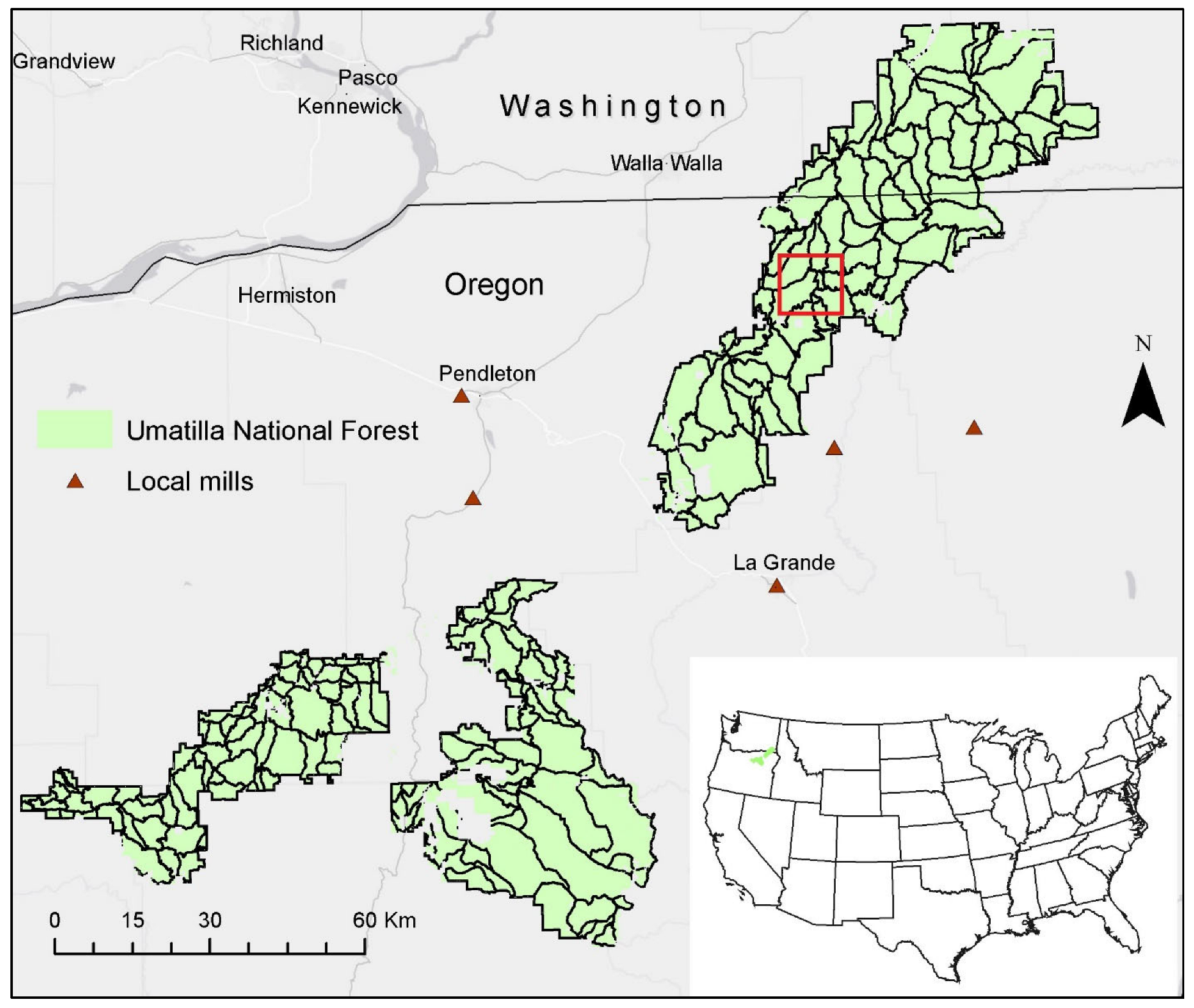
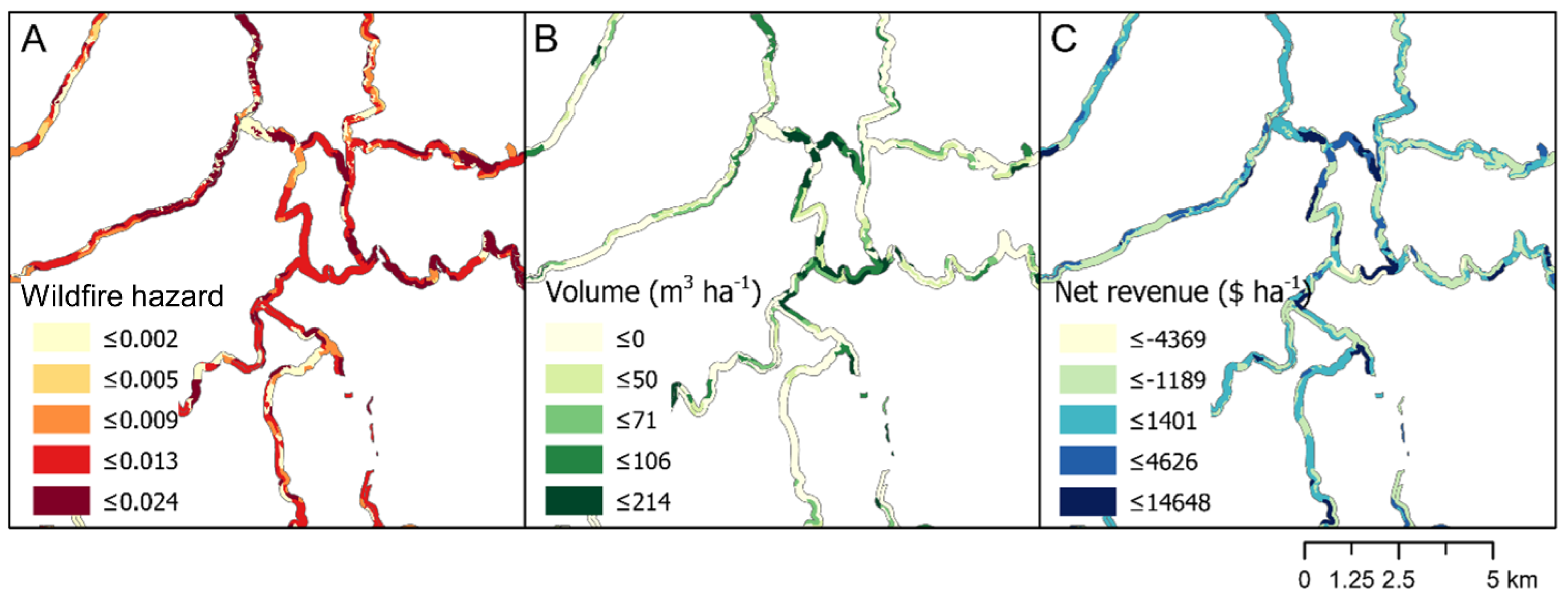

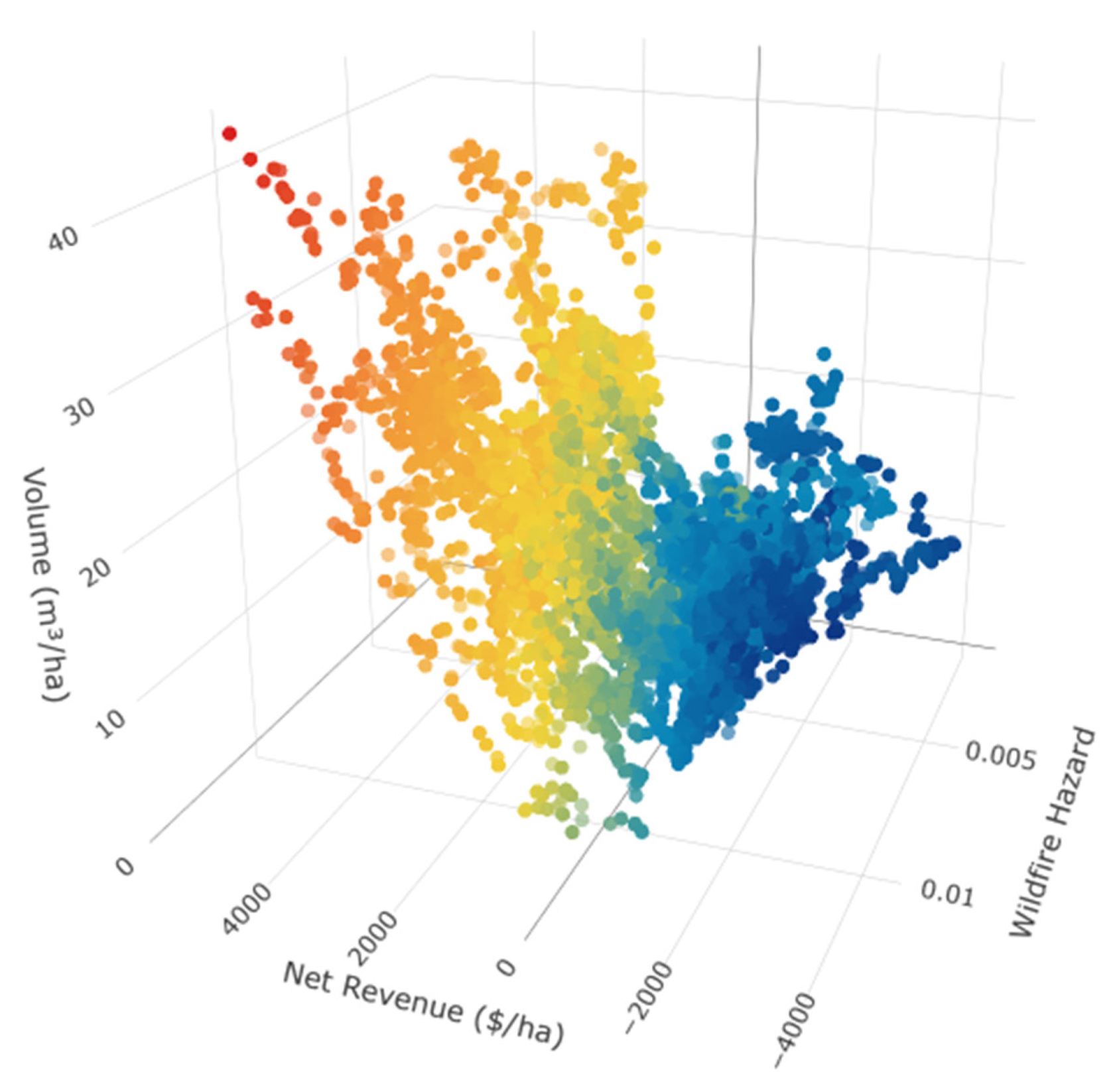
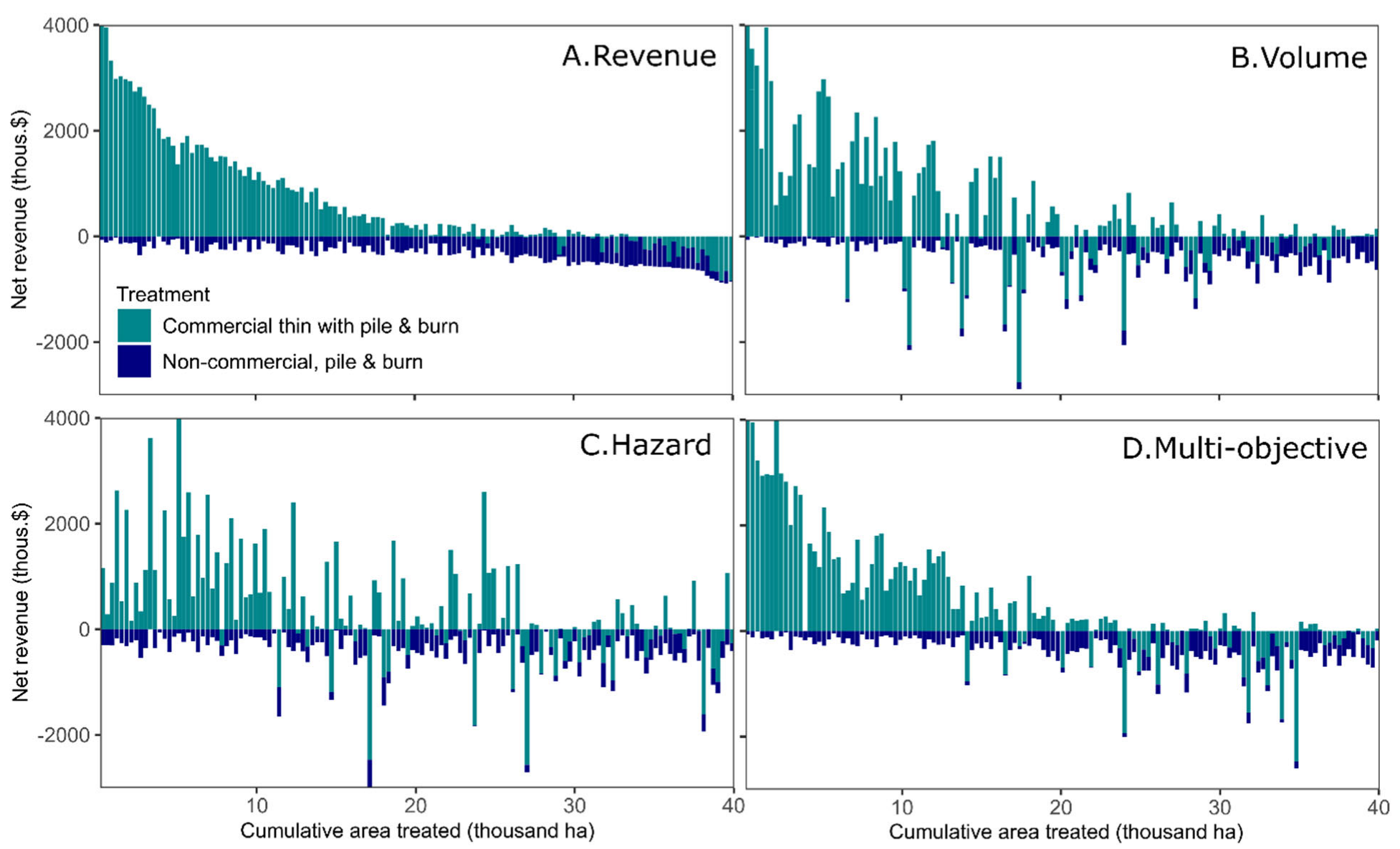
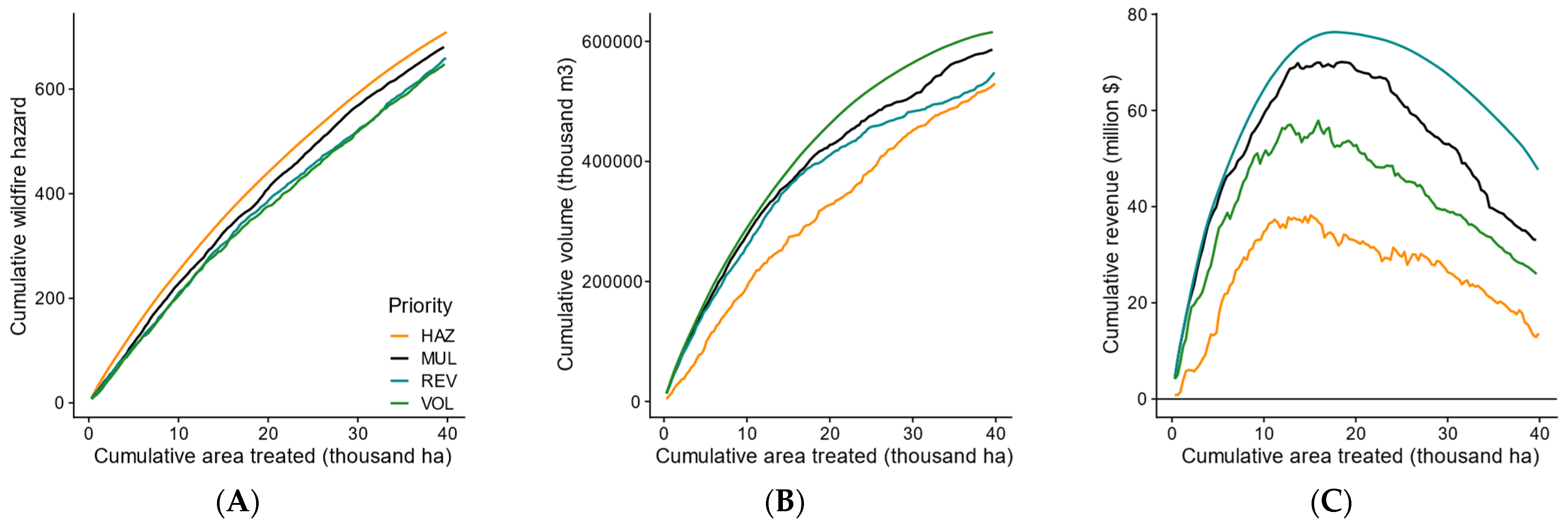
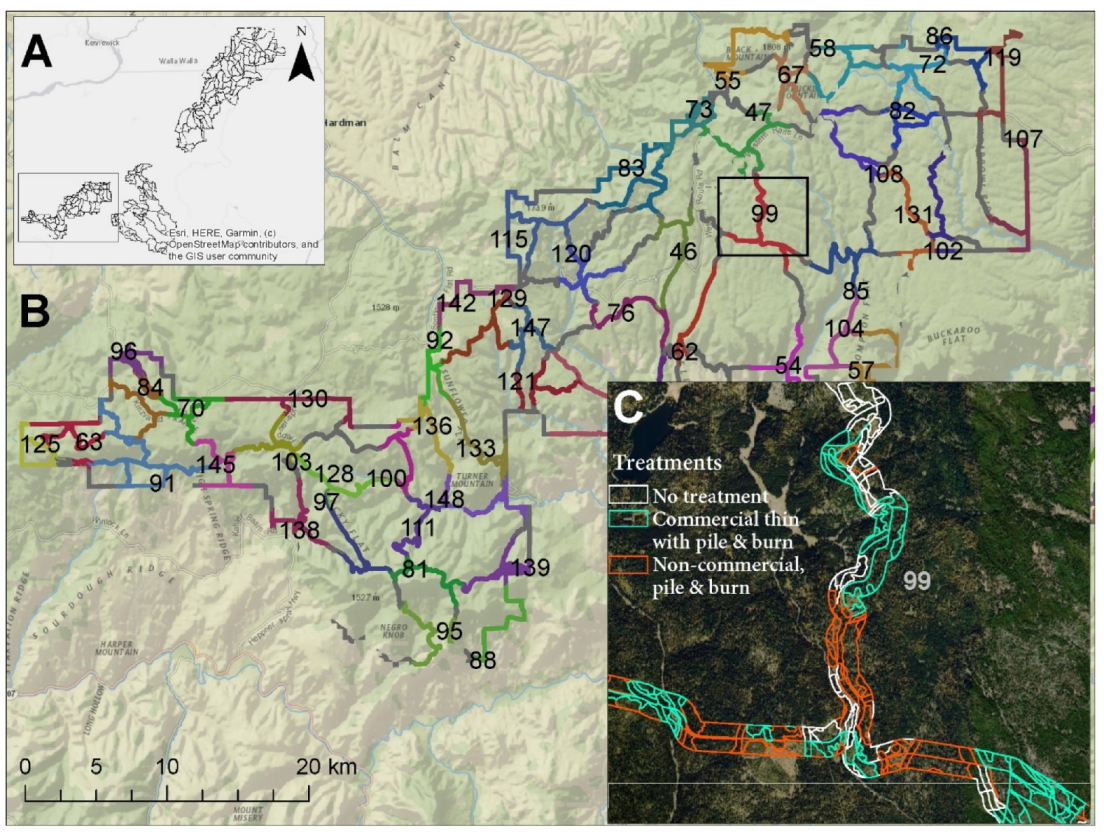
| Threshold | Treatment Types |
|---|---|
| Available for thinning |
| Commercial thinning |
| Non-commercial thinning (density reduction) |
| Thin + Pile and burn (2 years post-thinning) |
| Pile and burn only |
| Recently-treated forest, no treatment |
| Non-forest, no treatment |
| Objective | Treatment Area Per Project (ha) | Number of Project Areas |
|---|---|---|
| Wildfire hazard | 100 | 400 |
| Wildfire hazard | 300 | 133 |
| Wildfire hazard | 600 | 66 |
| Wildfire hazard | 1000 | 40 |
| Merchantable timber volume | 100 | 400 |
| Merchantable timber volume | 300 | 133 |
| Merchantable timber volume | 600 | 66 |
| Merchantable timber volume | 1000 | 40 |
| Net revenue | 100 | 400 |
| Net revenue | 300 | 133 |
| Net revenue | 600 | 66 |
| Net revenue | 1000 | 40 |
| Multi-objective | 300 | 133 |
Disclaimer/Publisher’s Note: The statements, opinions and data contained in all publications are solely those of the individual author(s) and contributor(s) and not of MDPI and/or the editor(s). MDPI and/or the editor(s) disclaim responsibility for any injury to people or property resulting from any ideas, methods, instructions or products referred to in the content. |
© 2022 by the authors. Licensee MDPI, Basel, Switzerland. This article is an open access article distributed under the terms and conditions of the Creative Commons Attribution (CC BY) license (https://creativecommons.org/licenses/by/4.0/).
Share and Cite
Belavenutti, P.; Ager, A.A.; Day, M.A.; Chung, W. Multi-Objective Scheduling of Fuel Treatments to Implement a Linear Fuel Break Network. Fire 2023, 6, 1. https://doi.org/10.3390/fire6010001
Belavenutti P, Ager AA, Day MA, Chung W. Multi-Objective Scheduling of Fuel Treatments to Implement a Linear Fuel Break Network. Fire. 2023; 6(1):1. https://doi.org/10.3390/fire6010001
Chicago/Turabian StyleBelavenutti, Pedro, Alan A. Ager, Michelle A. Day, and Woodam Chung. 2023. "Multi-Objective Scheduling of Fuel Treatments to Implement a Linear Fuel Break Network" Fire 6, no. 1: 1. https://doi.org/10.3390/fire6010001
APA StyleBelavenutti, P., Ager, A. A., Day, M. A., & Chung, W. (2023). Multi-Objective Scheduling of Fuel Treatments to Implement a Linear Fuel Break Network. Fire, 6(1), 1. https://doi.org/10.3390/fire6010001







